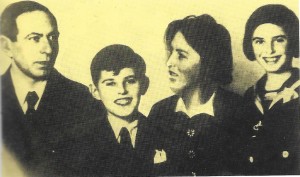
The life of Petr Ginz, an artist, writer, Esperantist, magazine editor and scholar, dramatically
illustrates the creativity and talent of so many
children who died in the Holocaust.
Petr was born on February 1, 1928 in Prague to Otto and Miriam Ginz. His father was a manager in a
textile company, and both his parents were
passionate about Esperanto. In fact, his parents met at an Esperantist convention and taught the language to Petr and his younger sister, Eva. The children were from an interfaith background; Otto was Jewish and Miriam was Christian.
From a young age, Petr’s intelligence, curiosity and passion for knowledge was evident. He wrote his first novel at age 8 and wrote 5 novels in all before he was deported to Terezin. A skilled artist, Petr also illustrated the novels himself. He was interested in a wide variety of subjects, including literature, art, science, history and geography, was an avid reader and also recorded his experiences in a diary. Petr’s enthusiasm for the arts and learning did not diminish after he was transported to Terezin at age 14, in October 1942. He continued his studies and borrowed countless books from the makeshift Terezin library, and wrote short novels.
He also made a major contribution to the cultural life of Terezin when he
established a literary magazine called Vedem (We lead), which he published weekly.
Petr wrote many of the pieces himself, and other boys from his barrack contributed work as well. The magazine featured pieces on daily life in Terezin, satirical essays, short fiction, poetry and artwork.
A close bond developed between the boys of Petr’s barrack, L417. They called their barrack the Republic of Shkid, and created a flag and national anthem. Their creativity
and imagination in such circumstances were remarkable, as was the amount of work
they produced for Vedem, much of which survives today.
Petr often wrote very matter-of-factly about the events he experienced and life in Terezin, and even managed to insert some humor. He did write some poignant pieces as well, most notably a poem in which he described how he much he missed Prague, though he knew it did not miss him. He described how he could not return because he was living like a caged animal but would always long for Prague, his “fairy-tale in stone.”
Tragically, he would never see Prague again. Petr was assigned to one of the last transports to leave Terezin, in September 1944. His sister Eva, who adored him, wrote about the day Petr was taken away in her own diary. After Petr boarded the train, Eva spotted him at one of the windows and managed to hand some bread to him before the guards chased her away. In her diary Eva poignantly expressed her fears about what happened to her brother and how she hoped against hope that he was still alive.
It was only after the the war that Eva learned the terrible truth, that at age 16 Petr
was murdered in the gas chambers of Auschwitz, along with thousands of others. A
prodigy was lost that day, and we will never know how many other gifted, talented
young people were killed with him that same day. All that remains today are the writings and drawings Petr left behind, which his sister Eva preserved and shared with the
world after the war. These works are the legacy of an incredibly gifted, creative, and
sensitive young man who held onto his dreams and his humanity to the very end.
Picture of the Ginz Family from Krizkova, Marie R., Kotouc, Kurt J. & Ornest, Zdenek. We Are Children Just the Same: Vedem, the Secret Magazine of the Boys of Terezin. The Jewish Publication Society, 1995. Print. Used with permission.
Further Reading
We Are Children Just the Same: Vedem, the Secret Magazine by the Boys of Terezin (by Marie Krizkova, Kurt Jiri Kotouc and Zdenek Ornest)
The Diary of Petr Ginz (edited by Chava Pressburger)